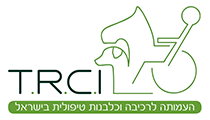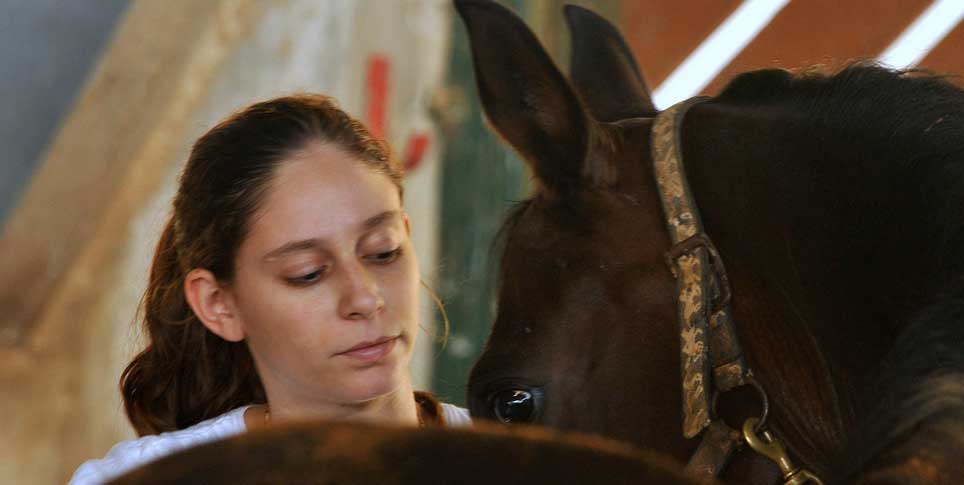This article deals with group therapeutic intervention with parents who beat their children, which
took place at TRCI in Tel Mond.
The purpose of the intervention was to improve and rehabilitate the relationships between
abusive parents and the children suffering from the violence. The parents who took part in the
program were integrated into group therapy in order to rehabilitate their relationship with their
children (once the physical abuse had stopped) as there really is no substitute for a family, even
if it is a dysfunctional one in some aspects and a source of dire frustration in the family’s life.
The combined therapy, that included animal assisted therapy, was selected due to its unique
qualities. The program included group therapy, for parents and children together at the
therapeutic kennel, with a wide range of activities that encouraged communication, enjoyment
and cooperation between parents and children. At the same time, there were therapeutic riding
lessons on horses as well as separate verbal group therapy for parents and children.
How does violence affect the mistreated children?
The level of the impact of violent behavior on children, depends on a combination of frequency
and the gravity of the violence. Children who are victims of violence in the family, will be found
to suffer from low self esteem, behavioral disorders, and difficulty in controlling impulses even
to the point of actual violence. As they grow up they experience anxieties of various kinds,
negative body image, and eating disorders. Other obvious results are a feeling of shame and
guilt. The children try and understand the violence against them and tend to self blame (very
much in accordance with the parents placing the blame on the children) and they are embarrassed
by the violence committed against them.
The therapeutic program presented, treated the children of abusive parents together with them, in
order to rehabilitate the dysfunctional relationship between them.
Animal Assisted Therapy
ATT, Animal Assisted Therapy, is therapy that uses animals, and relates to the use of animals by
therapists, in support of various kinds of treatment. The purposes of the use of animals in therapy
are: improving self image and self esteem, the ability to award warmth without any judgment,
improving communication skills, including a new object of attention in the therapy. The animal
offers consolation, soothing, security and attentiveness.
The psychiatrist A. Kutcher identified four components in the connection between man and
animals: awarding confidence, intimacy, closeness and consistency in the connection between
animals and people. The combination of these four elements provides the patient with health and
well being.
The need for family rehabilitation
In the past few years there has been an exponential increase in the number of reported cases of
violence towards children. However, experience proves that these parents are in dire distress due
to the precarious state of the family, the way legal process is carried out along with feelings of
guilt and shame. The probation services defined the purpose of therapy to stop violent behavior
towards children. Group therapy offers many advantages, as it helps deal directly with the
problem of violence and blocks it. However, putting an end to violent behavior does not do
enough to rehabilitate the family, as it is necessary to rebuild and restore the relationships
between the parents and the children. The group treatment plan with the assistance of animals at
TRCI in Tel Mond, has been chosen as the appropriate solution for the needs of both parents and
children.
Therapeutic intervention
In this program, parents and children who were found guilty of violent behavior or neglect, were
placed together, although participation in the program is not obligatory, and therefore it was
presented to the participants as being one where only those parents who proved strong
motivation and were highly committed, would be accepted. The chosen group included twelve
families, which met once a week for two and a half hours each time, for twelve weeks. Each
session included the experience of mutual training at the therapeutic kennel with an expert on
canine therapy, a riding lesson for the children as well as small therapy groups for the parents.
After conclusion of the therapy at TRCI, the families met with a social worker once in two
weeks, for continued assistance.
Therapeutic intervention with abusive parents and their children, using animals – Part 2
During the first stage, as part of the process of mutual decision making, the parents and children
hold a discussion in which they negotiate the kind of dog they want to work with. During the
debate, issues such as compromise, parental authority and mutual respect – come into play.
Training and emphasis on boundaries
One of the most important issues in dog training, is hierarchy and authority, and this is true of
parents and children too. The differences in behavior emphasize the discrepancies between
following rules and the lack of rules.
In the parents’ group, it is noticeable that there is considerable discomfort around the
implementation of boundaries, and this can be projected onto the spontaneous behavior of the
dogs which demonstrate the challenges of the participants as parents. For example: one of the
mothers gave the instruction to a dog to sit, and when the dog didn’t react, the mother responded
with violence towards the dog, which put its tail between its legs and avoided her. The therapist
at the kennel pointed this out and as a group they analyzed and processed the incident and came
to mutual understanding that there is an essential difference between violence and authority. The
mother understood that the dog responded to her in fear, as her children did, and therefore this
experience was meaningful and empowering for her.
Communication and mutual cooperation between parents and children
The work with the dogs, provides the children and their parents with the experience of warmth
without judgment, unconditional closeness and tolerance. The activities on the ranch began with
a treasure hunt game, and each clue had a snack attached for the dogs, which they found using
their sense of smell. For example: one of the mothers who was characteristically neglectful and
helpless, left her thin son to deal with a huge dog on his own. Later during the therapeutic
session, the group conversation led her to understand that there is a necessity to hold a dialog
with the child when you are performing activities together. Then, when the child’s shoes tore, the
foster family asked her to buy him shoes. A week later, she brought her son to the session with
new shoes, which made him very happy.
Trust
The issue of trust between parents and children is particularly problematic for this population.
The parent on his part, sees the child’s filing a complaint as a break in trust. The children see the
parents as violent, and thereby consider them to have broken the unwritten contract for basic
trust in their parents to take care of them, protect them and not be violent towards them.
For example: one of the fathers spoke violently towards his divorcee and included his son with
her as one entity. Another father heard his conversation and remarked to him that his son is just
waiting for him to relate to him with warmth, for a kind word, and he doesn’t see that because he
is busy winning the game. At the next session, following the group discussion, a game was held
and in it, in contrast to his previous declarations in which he stated that he didn’t rely on his son,
he allowed the boy to lead him blindfolded.
Cooperation and encouragement
The last session dealt with washing the dogs. This activity requires cooperation and allowed for
closeness between parents and children, along with a lot of enjoyment.
Afterwards, it was decided that the parents would watch their children riding. This caused much
tension in the children who wanted to impress their parents. Significant effort was needed to
calm things down with the children and to prepare the parents to encourage their children during
their riding and to show enthusiasm.
For example: a father who was distant from his introvert and insecure son, went through a
meaningful process and defined themselves in the final feedback as “team number one in
Israel”. During the sessions it was clear that the child had started to approach his father more and
to share the riding lessons with him. The father on his part enjoyed hearing his son talk about the
experience and expressed a warm and encouraging attitude.
Farewell
The children were restless towards departure, and found it difficult to cooperate, but the parents
were relaxed and tolerant of the children’s behavior.
The families and many friends were invited to the festive farewell ceremony. The children had
fun and proudly showed the guests their achievements in riding, and there was a performance,
medals and certificates of appreciation were distributed.
In summary
Throughout the process, we saw how therapeutic riding and dog training advanced the desirable
connections and social behavior of parents and children, reducing anxieties and fears and
feelings of loneliness, and served as a source of self confidence. The pleasant contact working
with the dogs, allowed for another channel of physical communication to replace the violent
contact. This therapy increases the feeling of capability in people. The work helped cope with
frustration and accepting an animal even if it doesn’t comply with the instructions given to it. It
helped parents learn how they can tame by reinforcing positive behavior and applying it to
raising their children. They learned to develop patience, to cope with frustrations and to accept
the children even if they didn’t obey them. We are hopeful that this feeling will stay with the
participants after this process and will enable the families to do well in the long run.


